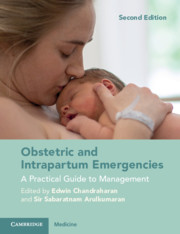Book contents
- Obstetric and Intrapartum Emergencies
- Obstetric and Intrapartum Emergencies
- Copyright page
- Contents
- Contributors
- Preface
- Preface to the First Edition
- Acknowledgements
- Section 1 General Principles
- Section 2 Algorithms for Management of the Top Five ‘Direct Killers’
- Section 3 Intrapartum Emergencies
- Chapter 8 Uterine Rupture
- Chapter 9 Breech Delivery
- Chapter 10 Umbilical Cord Prolapse
- Chapter 11 Fetal Compromise
- Chapter 12 Shoulder Dystocia
- Chapter 13 Twin Delivery
- Chapter 14 Instrumental Vaginal Delivery
- Chapter 15 ‘Crash’ Caesarean Section
- Chapter 16 Unintended Trauma and Complications During Caesarean Section
- Chapter 17 Obstetric Emergencies in Midwife-Led Settings
- Section 4 Postpartum Emergencies
- Section 5 Medical and Surgical Emergencies During Pregnancy
- Section 6 Anaesthetic Emergencies During Pregnancy
- Section 7 Neonatal Emergencies and the Management of Immediate Neonatal Problems
- Section 8 Management of Anticipated and Non-anticipated Emergencies in Pregnancy
- Section 9 Setting-Up Skills and Drills Training in Maternity Services and Reducing Avoidable Harm
- Index
- References
Chapter 10 - Umbilical Cord Prolapse
from Section 3 - Intrapartum Emergencies
Published online by Cambridge University Press: 06 May 2021
- Obstetric and Intrapartum Emergencies
- Obstetric and Intrapartum Emergencies
- Copyright page
- Contents
- Contributors
- Preface
- Preface to the First Edition
- Acknowledgements
- Section 1 General Principles
- Section 2 Algorithms for Management of the Top Five ‘Direct Killers’
- Section 3 Intrapartum Emergencies
- Chapter 8 Uterine Rupture
- Chapter 9 Breech Delivery
- Chapter 10 Umbilical Cord Prolapse
- Chapter 11 Fetal Compromise
- Chapter 12 Shoulder Dystocia
- Chapter 13 Twin Delivery
- Chapter 14 Instrumental Vaginal Delivery
- Chapter 15 ‘Crash’ Caesarean Section
- Chapter 16 Unintended Trauma and Complications During Caesarean Section
- Chapter 17 Obstetric Emergencies in Midwife-Led Settings
- Section 4 Postpartum Emergencies
- Section 5 Medical and Surgical Emergencies During Pregnancy
- Section 6 Anaesthetic Emergencies During Pregnancy
- Section 7 Neonatal Emergencies and the Management of Immediate Neonatal Problems
- Section 8 Management of Anticipated and Non-anticipated Emergencies in Pregnancy
- Section 9 Setting-Up Skills and Drills Training in Maternity Services and Reducing Avoidable Harm
- Index
- References
Summary
Incidence Varies from 0.1% to 0.6% (1–6 per 1000) [2]. Cord presentation occurs if the cord is below the presenting part but membranes are intact (Figure 10.3).
- Type
- Chapter
- Information
- Obstetric and Intrapartum EmergenciesA Practical Guide to Management, pp. 66 - 75Publisher: Cambridge University PressPrint publication year: 2021

